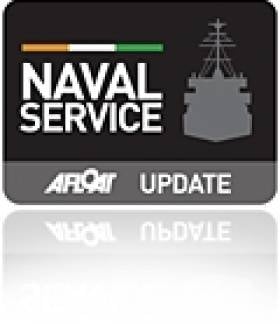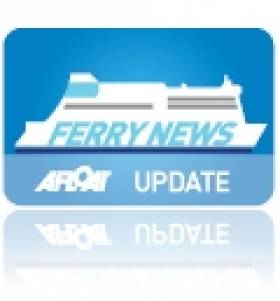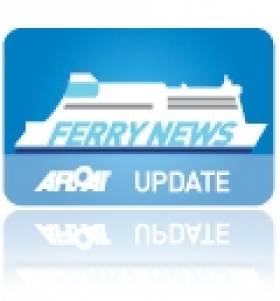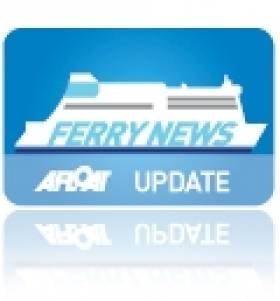Displaying items by tag: Ports and Shipping
UK Registered Trawler Detained off Bray Head
of the Gardai. The L.E. Orla which berthed alongside the harbour's Carlisle Pier, is designated as a coastal patrol vessel (CPV) along with sistership L.E. Ciara (P42).
This is the second detention of a vessel this year. According to the Naval Service in 2010 there were 1666 boardings carried out which resulted in warnings to 70 vessels and eight detentions.
Aran Island Fast-Ferries Sold to Mauritius Operator
The sale follows a previous attempt to dispose of the 234-passenger capacity ferries at an auction in Galway last month. Despite bids reaching €950,000, they were withdrawn at the auction which was also hosted by the Cork based auctioneer.
The vessels remain in Rossaveal but they will be transferred onto a cargoship as 'deck-cargo' to make the long delivery journey across the high seas for the new owners. Mauritius is neighboured by the smaller islands of Agalega, Cargados Carajos and Rodrigues which together form the Mascarene Islands, with the French island of Réunion some 200km to the southwest.

Sisters Clann na nOileáin and Clann Eagle I moored at Rossaveal. Photo
Jehan Ashmore / ShipSNAPS
With a streamlined aluminium 26m mono-hull design the vessels are capable of 19.7 knots. When the craft were constructed in 2006 they were worth between €5 and €6m. The pair were built in France by the OCEA boatyard at Les Sables d'Olonne, on the Bay of Biscay coastline, for Bád Arann Teo (trading as Aran Direct).
The company which went into receivership, operated on routes between Rossaveal and the Aran Islands (Oileáin Árann) of Inishmore (Inis Mór) Inishmaan (Inis Meáin) and Inisheer (Inis Oírr).
In recent years, Aran Direct had intended to introduce a larger passenger-only catamaran ferry on a new route between Galway and Kilronan, the capital of Inishmore and the largest of the three islands.
The fast-craft catamaran envisaged for the route was the U.S. based, 37m Harbour Lynx (2003/427grt) formerly Angel of Freedom, with a capacity for 300 passengers.To be renamed Aran Princess, the vessel was scheduled to take only an hour's passage time across Galway Bay.
In addition the revived route would have been the first direct 'passenger' carrying link between Galway City to the Aran Islands, since the closure in 1988 by CIE (Córas Iompair Éireann) of the three-hour route operated by the Naomh Éanna (1957/438grt).
Anniversary Sailing Bound for the Rugby
West Cork Tourism Co-Op launched the company a year ago as a result of a successful campaign to restore the direct service between Wales and the southern Ireland. Many businesses from the region and their Welsh counterparts invested in the co-op to restore the link since the closure by Swansea Cork Ferries in 2006.
Fastnet Line will continue to be in a celebratory mode with the first outbound sailing from Cork on Friday and which will also cater for a special-rugby supporters trip for this weekend's Six Nations Championship between Ireland and Wales at the Millenium Stadium, Cardiff. The Friday sailing departs Cork at 20.30hrs and arrives at 08.00hrs in Swansea on the Saturday morning with the game kicking off at 17.00hrs (5pm).
The company are offering various foot passenger deals to the match. A return bus transfer is also available between the ferry terminal and the game venue (but at an extra cost). In addition there are deals for those wanting to take the car. The after match sailing departs at 23.50 with the ferry arriving back in Cork at 12.00 noon on Sunday 13 March. For further information on fares etc click here
Enter European Endeavour
The European Endeavour will enable P&O to offer up to three Ro-Pax style sailings a day on the 7.5 hour route instead of the previous two-plus one Ro-Ro (freight-only operated) service. The 180m vessel is no newcomer on the route as over the last two years the ship has deputised to cover the annual overhauls of the routes' vessels.
The Spanish built vessel directly replaced the Ro-Ro freight ferry Norcape, which made her final sailing on the central corridor route, with the 1979 built vessel berthing at Liverpool's Huskisson Dock in the early hours of Sunday morning. Norcape could take 125 drop trailers but only had 12-passengers cabins (for freight accompanied truck-drivers).
Only last year the Japanese built vessel returned to the Irish Sea route as the Norcape but originally started a career with the B+I Line as their Tipperary on the Dublin –Fleetwood route. The UK port was switched to Liverpool in 1988, in the following year she was sold to North Sea Ferries.
The standing down of the Norcape represents the last vessel of the former B+I Line fleet to have any association with the Irish Sea. In 1991 the Irish state owned shipping company was sold to Irish Continental Group (ICG) which is a parent company of Irish Ferries. At that stage Irish Ferries operated only on the continental routes to France.
To read more about Norcape's final sailing on the Irish Sea route, click here.
Farewell to Former B+I Line Freight-Ferry
This will enable P&O to offer up to three Ro-Pax style sailings a day on the 7.5 hour route instead of the previous two-plus one ro-ro (freight-only operated) service. The Norcape could take 125 drop trailers but only had 12-passenger cabins (for freight accompanied truck-drivers).
Norcape was only re-introduced onto the Irish Sea last year but made her final departure tonight as the vessel headed into a foggy Dublin Bay.
In 1979 the Japanese built vessel was launched as the Puma for P&O but was chartered to B+I Line and renamed Tipperary. During the 1980's the vessel first operated a then new Dublin-Fleetwood route jointly operated with P&O, alongside Tipperary's Ro-Ro sister, Ibex. The P&O brand name Pandoro cleverly stood for P and O Ro, their roll-on roll-off freight division.

Cut-away deck profile of M.V. Tipperary and sistership of M.V. Ibex
The route's UK port switched to Liverpool in 1988 with Tipperary remaining on the route until sold to North Sea Ferries in 1989 and renamed Norcape. Prior to her transfer to the North Sea, the Tipperary collided with the 4,674grt bulker Sumburgh Head off the entrance to Dublin Port on 18 February 1988. For a report and photo taken of the two vessels which met at the port last year under different names click here.
Like the Tipperary the Sumburgh Head was built in Japan too by Hashihama Zosen KK, Imabari in 1977, yard no. 624. During her Dublin Bay incident, the vessel was owned by Christian Salvesen (Shipping) Ltd based in Edinburgh.
In 1990 she was sold to Barra Head Shipping Ltd and renamed Hood Head under the Irish flag. Three years later sold again to the KG Jebsen group and renamed Husnes.
The Panamanian flagged bulker remained with the Norwegian owner until 2003 when sold to her current owners, Wilson Shipowning AS of Bergen and renamed Wilson Tana, this time under the Maltese flag.
Celtic's French Ferry Figures
Operating the route is the 2008 built ro-pax Norman Voyager, at 26,500grt, the vessel has a larger passenger capacity for 800 and additional facilities compared to the previous vessel, Diplomat. In addition the newer Italian built vessel has space for 200 cars and 120 trucks. The ro-pax has a service speed of 22.9 knots is claimed to be the fastest ship serving on the direct routes to France, taking 18-hours.
In 2005 the Wexford based company took over the route from P&O (Irish Sea) and continued to offer what was primarily a freight-only service served by the existing route vessel, the 16,776grt European Diplomat. The vessel was also sold to Celtic Link and renamed Diplomat and could only provide a limited passenger certificate for 74, which was mostly taken up by truck-drivers.
With the introduction in December 2009 of the chartered Norman Voyager from Meridian Marine Management, the Diplomat was laid-up in Waterford (click here). The 1978 built vessel was then chartered by Celtic Link to trade in the Caribbean Sea.
Seatruck Sailings Start on Dublin-Heysham Route
The vessel has accommodation for 12 drivers. Most of the daily sailings depart Dublin at 15:15hrs and return from the Lancashire port at 02:15hrs. On certain days the schedules vary, to view the timetable click here.
In addition to the new route for Seatruck Ferries, the freight-only operator has a fleet of 8 vessels on routes between Dublin-Liverpool, Warrenpoint-Heysham and Larne-Heysham.
Anglia Seaways arrived into Dublin yesterday morning from Avonmouth Docks, where the 120 unit capacity vessel went into temporary lay-up period, since departing the Irish capital on 31 January (see related posting and photo).
The 13,073grt vessel revived the 8-hour route yesterday with an afternoon sailing bound for Heysham. The vessel was originally reported to be relocated to Baltic Sea operations, but with its charter to Seatruck, the DFDS Seaways funnel symbol of the Maltese cross was painted out.
Though, the Maltese cross can still be seen in Irish ports with calls made by sisterships, Dana Gothia (ex. Maersk Westland) and Dana Hollandia (formerly Maersk Waterford) which are part of the DFDS Group container subsidiary DFDS Logistics.
In total the Lo-Lo shipping division operates four vessels on several routing options with weekly calls to Belfast, Dublin, Cork and Waterford to Rotterdam and Zeebrugge.
The German built sisters originally operated Dublin-Rotterdam and Waterford-Rotterdam routes for Norfolk Line (a subsidiary of Maersk / A.P. Moller Group).Incidentally Maersk /Norfolkline also owned the Anglia Seaways until DFDS Seaways purchased the vessel last year.
Irish Sea Ferry Deal Under Review
Stena Line's acquisition of DFDS Seaways Irish Sea services in December, has now been referred to the UK's Competition Commission by the Office of Fair Trading (OFT).
The £40m ferry deal for two routes, Belfast-Birkenhead (run by two chartered ro-pax ferries) and the Belfast-Heysham freight-only service, included two 114-trailer capacity vessels.
The Competition Commission is expected to submit its findings by the end of July while the Irish Competition Authority is also still investigating the merger. To read more about this, click the BBC report here.
Seatruck to Re-Open Dublin-Heysham Route
Seatruck Ferries is to re-open the Dublin-Heysham route following the closure by DFDS Seaways of the freight-only service last month, writes Jehan Ashmore.
The first sailing of the revived route is scheduled to depart Heysham next Monday at 02.00hrs and the corresponding departure from Dublin is at 14.00hrs. Seatruck have yet to release the identity of the one-ship operated service, previously run by DFDS Anglia Seaways.
Seatruck decided to re-open the route based on strong demand and of the firm commitment to support the service from several road haulage firms.
To facilitate the additional business of the new route, Seatruck's existing use of Terminal 3 for its Dublin-Liverpool service will no longer be required. Instead all operations will be centred at Terminal 5, previously used by DFDS Seaways for their freight and passenger ferry vessels on the Heysham and Liverpool (Birkenhead) routes.
The company which is part of the Bahamas based Clipper Group Ltd (which controls 250 vessels) also operate between Warrenpoint-Heysham and Larne-Heysham. Seatruck operate an eight–strong Irish Sea fleet, which include four new vessels that were built in Spain and introduced onto two of their routes since 2008.
Lead-ship of the four 120-trailer capacity vessels, Clipper Point was followed by Clipper Panorama on the Warrenpoint route. The Clipper Pace and the final unit of the quartet, Clipper Pennant, serve on the Liverpool route. The new Dublin-Heysham route will increase the total number of all Seatruck route sailings to 80 each week.
Stena Purchase Former Irish Sea Ferry
The Dublin Seaways, one of the two ro-pax sisters that served DFDS Seaways Dublin-Birkenhead route, which closed down last month, has been sold to Stena Line, writes Jehan Ashmore.
DFDS Seaways sold the 21,856grt vessel to Stena North Sea Line for €24m. Stena operate the Killingholme-Hoek van Holland and Harwich-Rotterdam routes though it remains uncertain as to where the 1997 built vessel will be allocated to or possibly chartered.
Only last month, Stena entered into an agreement that offers their freight customers to use DFDS Harwich-Esbjerg and Immingham-Esbjerg routes. In essence Stena buys freight capacity from DFDS vessels through a so called 'space-charter' arrangement. Stena will be marketing the routes under their own brand.
In the meantime the Dublin Seaways is temporary running on DFDS Seaways Rosyth-Zeebrugge route in a freight-only capacity. The Scottish-Belgium route ended taking passengers in mid-December. The North Sea route remains the only ro-ro freight service operating between Scotland and to the continental Europe.
The second ro-pax that served on the Irish Sea route, Liverpool Seaways made a final call to Dublin port on 31 January (click here for picture and related story) prior to sailing for Immingham. She subsequently sailed on a repositioning voyage to the Baltic Sea, initially to take up service on the Kiel-Klaipeda route though the vessel is due to switch to the Karlshamn-Klaipeda route from 21 February.
Liverpool Seaways will be reflagged to the Lithuania flag and will replace the existing route ro-pax vessel, Lisco Optima which transfers to the Kiel route. Incidentally the Lisco Optima (1999 / 25,206grt) like the former Irish Sea sisters was also built at the Visentini shipyard in Donada, Italy.
DFDS Seaways exit of the Irish Sea ferry market also included the closure of the freight-only Dublin-Heysham route served by the 13,704grt Anglia Seaways. It was expected that the vessel would be transferred also to the Baltic, but the vessel remains berthed in Avonmouth Docks.







































































